Modoc Line
Over 100 miles of rail sit unused
in the high desert country of
Northeastern California. An unusual
situation and a rare opportunity.
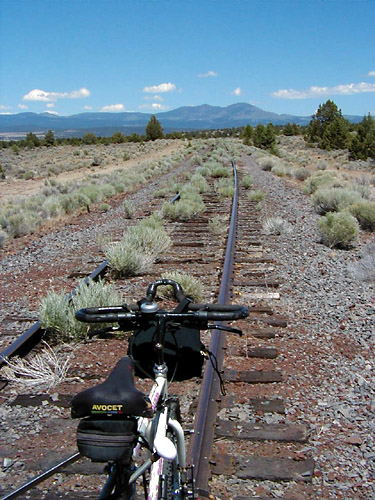
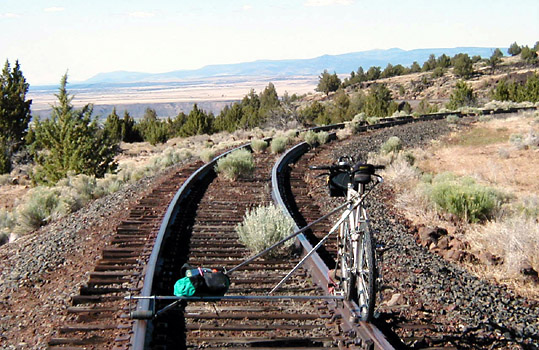
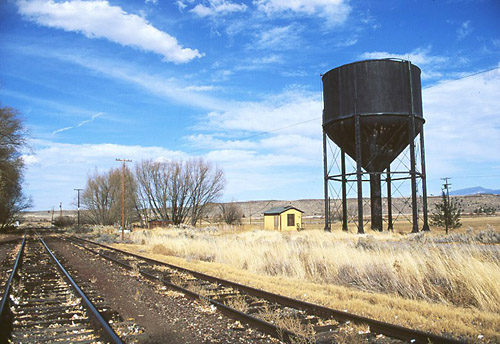
Descending Sagehen grade toward Likely
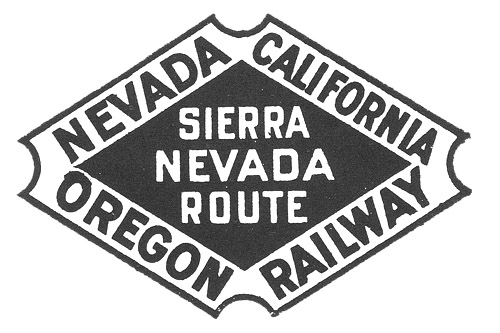
by Peter
The rails stretch ahead through a lonely desert landscape of sage and juniper. Tiny lizards scampered off the rails at my approach and an occasional buzzard circled overhead.
The old Southern Pacific water tower in Likely stands as a
reminder of the glorious age of steam.
Espee's famous cab-forward locomotives hauled heavy tonnage up the Sagehen grade in their final days of operation.
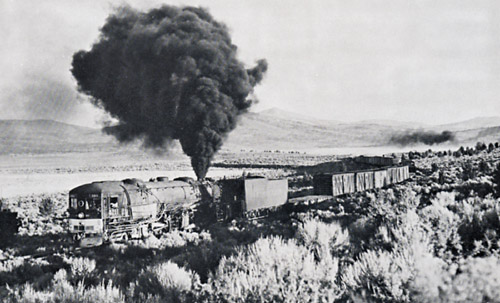
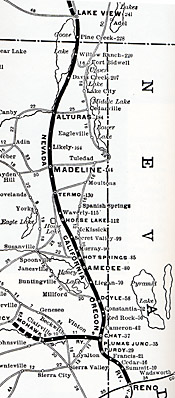
CALIFORNIA
OREGON
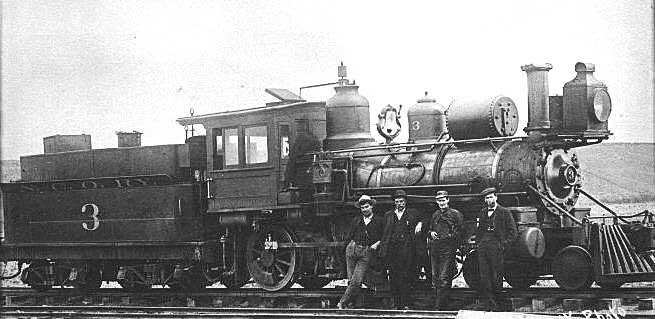
Use your browser's back button to return to the homepage
and you won't need to re-enter the password.
The Modoc line has a colorful history dating back to the late 1870's when it started its fascinating life as one of the longest narrow gauge railroads in the United States. Stretching from Reno, Nevada to Lakeview, Oregon, it covers 275 miles, traversing a high pristine desert landscape of juniper, sage, wide grasslands and volcanic outcroppings.
The Nevada-California-Oregon Railway was one of the most contrary railroads ever to appear on the Nevada scene. It started where it wasn't supposed to, went in a direction opposite than planned, and never arrived where it was intended to go. When it was first conceived, there was no rail service from Chicago to the Pacific Northwest. Until 1887, travelers bound from California to Oregon or Washington faced a perilous ocean voyage or a rugged stage trip of as much as
a week's duration.
Unfortunately, the northwest connection at the Columbia River was never realized. Anticipated passenger service died with this failure and the N-C-O became dependent on cattle, sheep and lumber for most of its business. The line was often referred to as the "Narrow, Crooked and Ornery" and the "Northern California Outrage".
The railroad did well for a while after a rough start which included a gun fight at a directors' meeting which left one dead. But by 1914 the line was consistently running in the red. The narrow gauge was at a big disadvantage competing against two standard gauge trans-continentals, the Central Pacific and the Western Pacific, both of which eventually ended up owing much of the line.
Nevada-California-Oregon Ry
in the early 20th century.
In 1935 the bulk of the N-C-O was sold to the Southern Pacific and shortly afterwards converted to standard gauge. The S.P. had acquired a rather unusual railroad. The line crossed numerous mountain ranges without any tunnels and crossed a variety of water courses without any major bridges and along its entire 275 mile route it connected with no independent mining or logging railroads. What little industry there was could be counted on the fingers of one hand. Quite obviously, its greatest value lay in the role of a bridge line between Espee's mainline at Reno and the Pacific Northwest via Alturas, California.
This may be its only saving grace today. The current operator, the Union Pacific Railroad, applied to abandon the line between Wendal, Nevada and
Alturas in 1996. The following year when floods closed down the U.P. mainline in the Sacramento River Canyon, the Modoc line was temporarily reopened to handle the emergency, but has not been used since. No new operators have shown
interest in the line. Although the government believes the line should be "railbanked" for national security,
the rails may eventually come up.
Its ultimate fate may be decided within the current year.
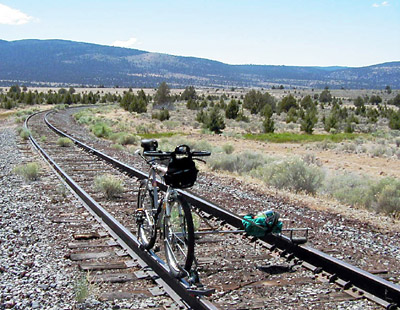
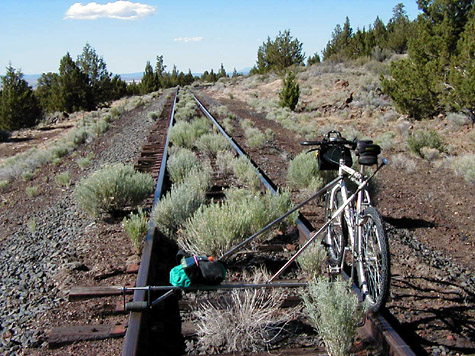
Left: The ascent rises from the valley floor
and edges it way along a broad platueau.
Right: Sagebrush between the rails was a real pain, making the climb more difficult.

The northernmost section of the original N-C-O from Alturas to Lakeview was purchased by the government of Lake County, Oregon, as the only alternative to saving rail service to the isolated county seat in Lakeview. Even this came close to failure when the only lumber company in town drastically cut back its operations. Only recently did the line become viable when a ryolite mine opened north of town and became its only substantial shipper. This section of the line is perhaps the most scenic, skirting the shores of Goose Lake, the habitat of thousand of Pelicans, Snow Geese, Canadian Geese and Swans. Currently, the Lake County Railroad operates trains just two days a week, on Monday and Friday (a ride story to follow).
Two sections of the abandoned Modoc line between Wendal and Alturas are suitable for railbiking (you didn't think I'd ever get to it). Both turn far away from Highway 395 and head out into the desert wilderness. The section between Likely and Sagehen was my choice this trip. The other section, between Ravendale and Viewland, will be attempted at a cooler time of the year.
My ride began about one mile south of Likely, a town that never lived up to the promise of its name. Buy your gas and food stuffs before you get there. About the only thing left in Likely is the old Southern Pacific water tank, a relic of steam's glorious past. I found a secure spot on a dirt road paralleling the tracks and out of sight of the highway to set up my bike and leave my Blazer. From there I could see up the shallow canyon where the rails made two sweeping turns before beginning the 14-mile climp to Sagehen. The elevation is 4445 in Likely and the rails reach 5548 at the summit.
Just past Sagehen is the town of Madeline and there's a short climb coming from the opposit direction,
known as "Madeline Hill". In 1916 when twenty feet of snow stranded a train on the grade, a curt message to the dispatcher from one of the snowbound crew stated: "Am stuck on Madeline Hill!" To which the dispatcher tactfully replied, "Well marry the girl and come on in."
Setting on at two in the afternoon, I wasn't sure that I could climb to the summit and return before evening. Although only a 28-mile round trip, I had no idea what lay ahead. I had the option of breaking down the railbike and riding back on the highway. The two-lane highway,
Sagehen summit, what a disappointment. No soaring mountain peaks or grand overlooks, just two miles of double track.
however, has no shoulders and I dreaded the thought of those big rigs roaring by and sucking me under their wheels.
After a few miles on the rails I had doubts about making the summit at all. The sage had grown thick and high. With my low outrigger I had no choice but to plow on through and the bike would jerk dangerously as it struck each bush. This slowed my progress considerably, but caused no mishaps. The grade, although not terribly steep, was unrelenting and the afternoon desert heat was sapping my strength. A nasty headwind added to my woes. It was one of those times when you question your purpose, if not your sanity. "What am I doing out here in the wilderness inflicting pain and misery on myself?" I asked. But to give up before reaching the summit, well, could I ever face myself again? But knowing that difficult adventures may leave the most cherised memories, I continued on. The climb and the view seemed never to change. Ascending the grade I could only see the ridges ahead of me, and was not able to enjoy the sweeping vistas to my rear. Around every bend there was only another just like it.
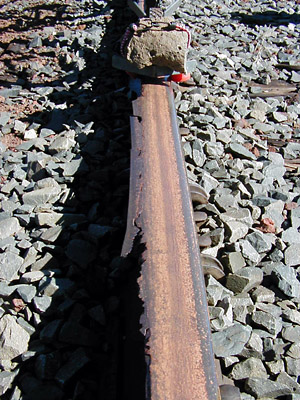
A rock tied to the top of my front wheel guide kept it on the rails over these pancaked sections.
The thought of reaching the summit was all that kept me going, but once there it was a big letdown. Stretching ahead was a long, lonely siding that I knew to be at the top. No mountain peaks, no grand overlooks, just two miles of straight, level, double-track. There was no "other side" to look down upon. Ahead lay the Madeline Plains. I had reached the top of a broad plateau.
It was only 4:30. I had made better time than expected, derailing only once when I hit a meadow muffin sitting square on the top of the rail. If you're
going to "buy the farm" I can't think of a more apt ending. But thankfully, no injuries, they're not allowed when you're riding by yourself.
The highway option was discarded and I turned my bike and headed back down the long grade toward Likely. After all, I had earned it. On the descent I encountered several sections of badly pancaked rail. Tying a heavy rock to the top of my front wheel guide kept it on the track without incident, but I had to remain highly alert to the re-occuring hazard.
There were also numerous wheel flange greasers which could cause serious trouble but most were easily seen allowing plenty of time to stop. The rails were rusty, but not heavily so, indicating the railroad was perhaps making periodic inspection runs. And lucky me, no highriders were encountered this time out.
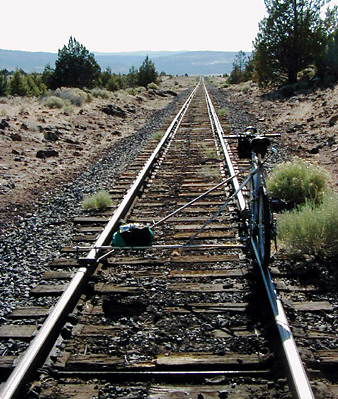
Riding the final miles into Likely I was leg-tired, butt-sore and desert-fried and happy to end of this day. Would I do it again? You bet! But I'll wait to come back until early Spring when the snow is still on the monutains and the air is brisk and refreshing.
At present, 100 miles of rail sit unused, an unusual situation on the West Coast and an outstanding opportunity if you can take advantage
of it.
On the final miles into Likely I was leg tired, butt sore and desert fried. Just over that next rise (photo right) I could see the Blazer waiting for me and knew the ride was almost over.
The
 | ||||||